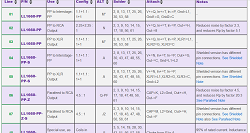EE27 Board for Large Signal Transformers
For: LL1660, 1660S, LL1667, LL1668, LL1671, LL1677, LL1689, LL1692A, LL1694, LL2731, LL2745, LL2754, LL2763, LL2766
 Introduction (you are here)
Introduction (you are here)- Programming the EE27 Board
- Technical Bulletin about this transformer family
Introduction
|
| All in all, the number of versions and things you can do with those, is incredible high. Perhaps because of all this many possibilities, we see users often just copy something which they believe it works. That can be something from the internet, or an application from the data sheet. However this stays a difficult decision. So hopefully these programmable boards will encourage you, to try out some more different configurations. |
| Though it may initially seem more difficult to use the EE27 board, in fact this makes it a lot more easier. Once you have the transformer with the board attached to it, in front of you, it will be clear it is only a matter of placing the right solder jumpers, and just attach input and output wires. The programming you don't need to find out yourself. Just take the applications we list here, and just a few minutes later, you have a working transformer in front of you. We have all data sheets applications, the "ALT-x" versions in there, but also some new ones, and sure more interesting ideas will be found by users, and we can l add those. |
| Moreover, in case you want to change the windings ratio, you do not need to take all the wiring off any more, and re-solder all wires. With the EE27 board, the solder jumpers are very easy to remove and the transformer can be re-programmed. |
If some special applications give a better square wave response, with termination of the outputs, the data sheet will say so. It works always best when this is attached directly to the transformer. For these parts , if they are needed, we reserved a place on the EE27 board. There are four solder islands, Z1, Z2, L1 and L2 , reserved for this. If so it will normally be one resistor from Z1 to L2, and one from Z2 to L2. While L2 is connected via the matrix to signal ground. Also this you don't need to find out yourself, it is prepared in the programming table. |
|
 Lundahl's most successful transformer series of this kind, is the family of LL16xx of 27xx. These differ only in the windings ratio.
Each type is available in three versions:
Single Ended, Push-Pull, and Parafeed (PPZ). This means different cores. Then, each core can be supplied as amorphous or iron, so we have 6 possible cores for each type. Then the way to interconnect the windings (the programming) is full of possibilities, and in the end, each transformer can be used reversed too, which adds even more interesting applications. Because of the matrix programming, we can connect the terminals of each winding to any other. For instance putting all small windings of
Lundahl's most successful transformer series of this kind, is the family of LL16xx of 27xx. These differ only in the windings ratio.
Each type is available in three versions:
Single Ended, Push-Pull, and Parafeed (PPZ). This means different cores. Then, each core can be supplied as amorphous or iron, so we have 6 possible cores for each type. Then the way to interconnect the windings (the programming) is full of possibilities, and in the end, each transformer can be used reversed too, which adds even more interesting applications. Because of the matrix programming, we can connect the terminals of each winding to any other. For instance putting all small windings of 